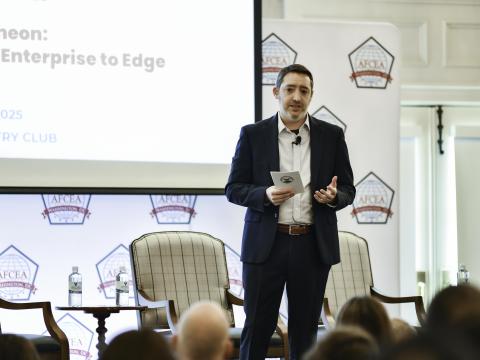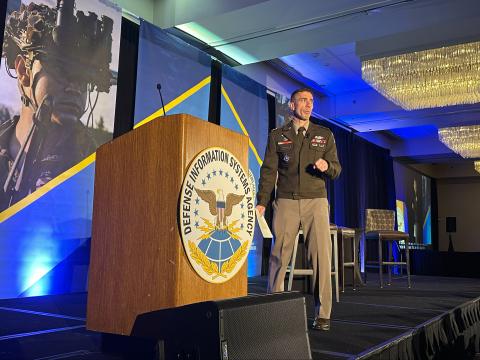Spiraling Under Control
Large-scale government outsourcing requires both control and flexibility.
A multimillion-dollar U.S. Air Force project that streamlines financial information sharing processes is coming to fruition using an approach that facilitates responsiveness to requirements changes and incrementally delivers capabilities. The system goes into production this month after two years in development.
Many government and military executives become justifiably skittish when considering a large-scale outsourcing project. Multiyear, multimillion-dollar deals are highly complex. Many high-profile projects involving military hardware or information technology seem inventive at the proposal stage but miss the target once implemented. The phenomenon occurs in part because it is nearly impossible to forecast and map out all of the vital requirements and responsibilities up front.
Realistically, a project team cannot anticipate and compensate for the inevitable fluctuations in scope, requirements and contingencies that crop up months and sometimes years later. The project team is essentially tasked with hitting a moving target and one that dodges unpredictably and erratically.
One way to address this challenge is to build flexibility into the entire structure starting right at the beginning of every major project. Rather than use a traditional linear methodology that concludes with a “big bang” release several years later, the Air Force is following a spiral development model in a six- to 10-year project budgeted at $40 million.
Accenture L.L.P., a global management consulting and technology services company, is the lead contractor helping the Air Force design, build and run the Financial Information Resource System, or FIRST. Currently, the Air Force has three separate stovepipe systems pumping out financial information to headquarters, major commands and bases. FIRST, the development of which began in April 2001, is designed to reduce this complexity to a single, integrated financial information and budget-decision-support system.
FIRST will have a consistent look and feel to everyone with authorized access. In addition, the system will be accessible through a secure, Web-enabled infrastructure. Consequently, whether at the Pentagon or at a remote location with a satellite connection to the Internet, users will be able to find information in a convenient and timely way. FIRST could benefit more than 6,000 users and meets Global Combat Support Systems–Air Force technical standards.
The budget-decision-support system goes into production this month. After this initial incremental step, the team will continue with the spiral development model. Each major release comprises two or three spirals, with each wave containing design, build and test phases. The resolution of each spiral builds in continuous improvement and confirms achievement of the program’s goals. Because adhering to schedule and budget is a major concern, the team will remain flexible on reallocating requirements from one release to the next.
The theory and practice of spiral development emerged in the 1980s when software engineers experienced the failure of large-scale projects. Barry Boehm, director of the Software Engineering Center at the University of Southern California, Los Angeles, is widely credited as the leading proponent of this style of project management.
Sources at the Center for Software Engineering, a federally funded research and development center sponsored by the U.S. Defense Department and operated by Carnegie Mellon University, Pittsburgh, define spiral development as an approach in which risk evaluations drive the choice of development activities in each of a number of iterations. In this context, risk can be thought of as the chances that users’ most important concerns will not be sufficiently addressed.
The spiral approach differs from a traditional linear approach, also known as “waterfall” project management, in which the direction of the project is set by a narrow source of authority high above then cascades down to people at lower levels of the organization. The imagery conveys the sense of an irreversible flow of change from original objectives to the execution of a software solution.
This waterfall approach makes sense when development challenges are clearly understood; however, this does not often happen on a long-range project. Janet Roth, an Accenture associate partner on the FIRST project team, notes, “I’ve never seen a software development project that didn’t have significant changes in requirements.”
Another problem with this model is that risks increase the longer it takes to deliver the final release. The time from inception to completion can be extended so long that the requirements may have changed radically from those at the project’s inception, and the final release may not meet users’ new requirements. Instead of producing a big bang, the waterfall can result in a big and costly washout, Roth points out.
FIRST team members use a rolling-wave project-planning concept whereby they initially target the highest priority or riskiest requirements. Changes to specifications are re-prioritized as they arise, with recommendations from Accenture about how to minimize cost and the effect on schedules.
The spiral approach poses several challenges, however. For example, when a project team promises to address users’ concerns and accepts a requirements creep, the program may spin out of control in terms of time and cost. To address this concern, the FIRST project team establishes high-level cost and schedules targets for major releases, then performs detailed, bottom-up plans every few months. Developing detailed plans on a periodic basis keeps plans more accurate and helps to manage resource needs better.
At the end of the first increment, for example, the team will not simply push forward with the next phase. Instead, it will take time to pause and re-examine the customers’ changing priorities. If some users acknowledge that they stated they wanted X but realized that they meant Y, it is understandable. However, to adhere to the schedule, which is a top priority, the customers understand that whenever they target a different feature or function, they must identify another item of equal magnitude to push down on the list.
As effective as the spiral model is, it cannot function under a rigid contract structure. An adaptable contract vehicle is required to respond to changing process needs. The FIRST team has instituted well-defined procedures for identifying changes within the project parameters and those that are out of scope. These procedures ensure that the Air Force and Accenture agree on how to handle changes and which processes to follow.
The FIRST contract vehicle uses a cost-plus-award fee structure. Base labor costs and expenses are paid monthly while profits are awarded every six months if the project achieves specific performance goals. This award fee method allows the Air Force to evaluate actual performance and the conditions under which it was achieved. This type of contract is suitable when uncertainties exist and do not permit costs to be estimated with sufficient accuracy to use a fixed-price contract.
When estimates change, this contract vehicle allows alteration of the established price ceiling. For example, during the first two years of the FIRST contract, 10 contract changes have been proposed. From requirements definition through pricing, an integrated product team comprising Air Force, Accenture and Defense Contract Audit Association members handles all such change proposals. The integrated team helps to streamline the process and accelerate the contract award.
The Air Force continues working with Accenture personnel to increase contract flexibility. With each modification, the service adds new contract line items that incorporate the required changes as well as accommodate future growth. This line-item approach saves considerable time and simplifies the contractual process.
Rather than simply handing off development to Accenture, the Air Force remains closely involved in all phases of system definition, development and delivery. It encourages steady involvement of integrated product team members because they are more likely to specify important modifications and be pleased with the outcome if they are actively helping to develop the new system.
Air Force personnel work alongside an Accenture team when they need to assemble the new proposal that emerges from changed priorities. Rather than having the principal contractor independently assemble a proposal that will need to bounce back and forth between the company and the Air Force several times, this collaborative process saves time and money.
With several years left on the contract, FIRST remains on budget and on schedule. The delivery model breaks down complexity into manageable components. It is outsourcing on a grand scale but done through a series of tightly managed phases that add up to a successful outcome, regardless of the inevitable twists and turns already experienced.
For the Air Force finance people, the FIRST system is about getting the right information to the right people so they can make the best decisions, particularly during a time of heightened concerns over national security. By delivering a much firmer grasp of the financial issues, FIRST provides decision support that will put the service in a better position to determine how much money is being spent and where, and what funds will be available to best achieve national security objectives.
Dane Warf is deputy director of the Financial Information Systems Program Office, U.S. Air Force Electronic Systems Center, Hanscom Air Force Base, Massachusetts.




Comments